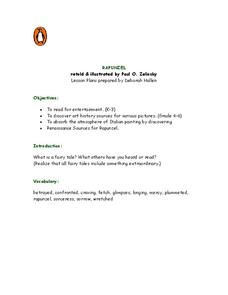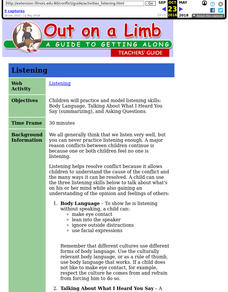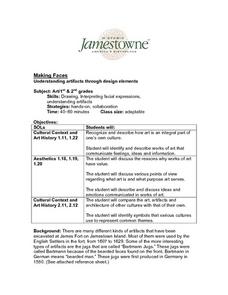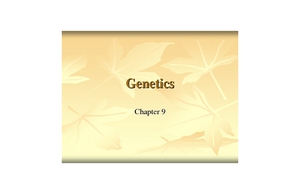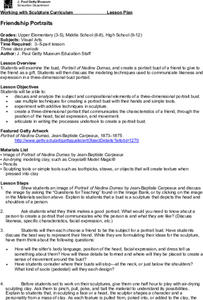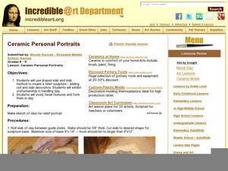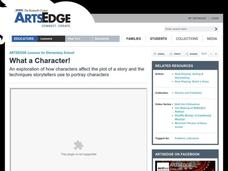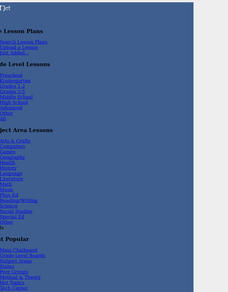Curated OER
Writing About Photographs: Responding to the Art of Dorothea Lange
Students view and discuss photographs by Dorothea Lange. They describe what they see, pose questions about the images, reflect on their personal responses, and create diaries written in the voices of individuals depicted in the images.
Curated OER
Harry Potter And The Prisoner of Azkaban Magic Square!
Readers of Harry Potter and the Prisoner of Azkaban, the third in J. K. Rowling's series about the young wizard, complete a magic square using words drawn from chapters six and seven of the novel.
Curated OER
Texture Sculpture
Students explore a variety of everyday objects and group them according to their textures. They create a clay portrait, learning how to manipulate the material and tools to create different textures.
Curated OER
Rapunzel
Youngsters read the story of Rapunzel and go over vocabulary and answer discussion questions. They also list qualities of characters, discuss settings, make a diorama, and more.
Curated OER
A Guide to Getting Along: Listening
Here is an effective way to have your charges practice and model important listening skills. After a short review of effective active listening concepts, such as using body language, summarizing what the other person said, and asking...
Curated OER
Pantomime Exercise
Learners of any age can learn to communicate using gestures and their bodies. They create a pantomime of a specific activity without using any words. This resource includes a link to an Off-Broadway Workshop for kids.
Curated OER
Writing Process- Narrative Writing
Graphic organizers are a wonderful tool for young writers to use to help them get their thoughts in order for a piece of writing. Here, learners are coached on what a piece of narrative writing is, and how they must have a distinct...
Brain Targeted Teaching
Tuck Everlasting Novel Study
The broad ideas included here provide clear ideas on how to use brain-targeted learning, what activities work best with Tuck Everlasting, how to apply the knowledge gained from their reading, and ideas for evaluation. Not teaching...
Curated OER
Making Faces: Understanding Artifacts Through Design Elements
Learners examine and discuss drinking container artifacts from Jamestown. They view images of the artifacts, discuss their purposes, draw an original facial expression for a brown paper jug, and write a description of the facial expression.
Curated OER
Civil War Reader's Theater Lesson Plan
Students participate in a reader's theater about the Civil War. In this performing arts instructional activity, students review the Civil War through a reader's theater. They practice reading their parts to work on expression and...
Curated OER
Polykleitan God or Athlete
Students analyze the Polykleitan God depicted in art and create their own ideal form of sculpture. In this sculpture and art lesson, students read about Greek art of the human form. Students analyze the art of Polykleitos and then create...
Curated OER
Theatre Lesson Plan- Tableau (part 2)
Students explore tableaux. For this social studies and fine arts cross curriculum lesson, students work in groups of four to create "frozen" stage pictures (tableaux) representing vocabulary and concepts from a "From Farm to You"...
Curated OER
A Happy Time
Second graders listen to stories about feelings, identify their own feelings at specific times in their lives, and express their feelings in words and through writing.
Curated OER
Genetics
Students identify literary elements in each selection while learning about diversity and the struggle for equality in the United States. They use their knowledge to express the emotion and key literary elements in each piece through...
Curated OER
Linking Rembrandt and The Odyssey
Students apply knowledge of the style and techniques of Rembrandt to illustrate characters from The Odysey. They respond critically to a variety of works in the arts.
Curated OER
Crayola® Model Magic® Colored Courtly Characters
Learners create a "Noh"-style mask, based on Japanese Noh theatre masks. They experiment with different colors of modeling clay and explore ways to show facial character.
Curated OER
Paper Face
Students examine the differences between each person's face and facial features. They draw a simple sketch of their face onto a paper plate. They investigate different 3-D textures and how to apply them as decoration.
Curated OER
Friendship Portraits
Students explore sculpture. In this lesson about sculpting, students create a portrait bust. Students choose a classmate to make a bust of and apply all of the necessary elements to their bust. Students will have a better understanding...
Curated OER
Body Language
Young scholars take pictures in different settings to demonstrate the importance and influence of body language. In this body language lesson plan, students use a camera and work in groups over a 5 week period.
Curated OER
Ceramic Relief Portrait
Eighth graders use draped slab and slab method to create a relief sculpture, adding coil and slab decoration. They study facial features and form them in clay. They study symbolism in Renaissance relief terra cottas.
Curated OER
Acting Out The Story, Jane And The Dragon
Third graders reflect on and discuss the story, Jane and the Dragon, and portray their understanding of stereotyping through the actions of their character. Through the use of legends, drama can be used to educate understanding for other...
Curated OER
Playing with Puns
Students examine the wit of characters in two plays. In this drama lesson, students read The Shakespeare Stealer by Gary L. Blackwood and Twelfth Night by Shakespeare. Students analyze the puns used in both plays and write essays that...
Curated OER
What a Character!
Students look at the role of characters in a story. In this character lesson, students discuss how different types of characters change the plot of the story. They see how storytellers use their body, face, and voice to tell stories.
Curated OER
Language with Linguistic Legos
Students visualize and manipulate sentences as building blocks, and, given a key, use Legos™ to demonstrate how to construct sentences of variety (simple, compound, complex, and compound-complex).



